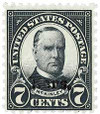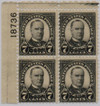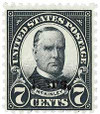
1929 7c McKinley, black, Kansas-Nebraska overprints
# 665 - 1929 7c McKinley, black, Kansas-Nebraska overprints
$24.00 - $575.00
U.S. #665
1929 Kansas-Nebraska Overprints
7¢ Kansas
1929 Kansas-Nebraska Overprints
7¢ Kansas
Issued: May 1, 1929
First City: Colby, KS
Quantity Issued: 1,320,000
Printing Method: Rotary Press
Perforation: 11 x 10.5
Color: Black
First City: Colby, KS
Quantity Issued: 1,320,000
Printing Method: Rotary Press
Perforation: 11 x 10.5
Color: Black
The 7¢ Kansas stamp was overprinted on U.S. #559, picturing William McKinley.
Gunslingers, Homesteaders, and Gangsters
The western terminal of the Atchison, Topeka and Santa Fe Railway and the end of the Chisholm Trail were located in Kansas, giving the state a crucial role in America’s westward expansion. Spurred by the Homestead Act, thousands of acres in Kansas were claimed by settlers. Out of this rough and tumble pilgrimage came some of our nation’s most colorful characters – among them Wild Bill Hickok, Bat Masterson, and Wyatt Earp.
Although frontier towns in Kansas would turn out a number of distinguished Americans – including President Dwight D. Eisenhower and aviation pioneers Charles Lindbergh and Amelia Earhart – the lure of the West was tempting for some criminals. By the 1920s, machine gun-toting gangsters had replaced gunslingers, and small post offices in isolated communities were among their targets. Losses in one year alone totaled more than $200,000 (equal to nearly $7 million today). To make it difficult for thieves to sell stolen postage stamps, Postal Inspector Louis Johnson proposed stamps be overprinted with the name of the specific state where they would be sold.
The idea of overprinting U.S. stamps to prevent theft wasn’t a new one – it had been suggested nearly 30 years earlier – but the newly invented rotary press now made the idea possible and affordable. As one of the states victimized by postage stamp theft, Kansas was selected for the experiment. If successful, authorities planned to distribute overprinted postage stamps to each U.S. state within one year.
Issued in Very Low Quantities – Many are Hard to Find
Although it had seen rapid growth, the population of Kansas was relatively small in 1929. Based on projected needs, postal officials distributed relatively low numbers of Kansas overprints. In fact, less than one 9¢ stamp was issued for each person living in the state.
The Kansas Overprints were released in the cities of Newton and Colby – and were met with immediate criticism and confusion. Some postmasters refused to honor them, believing the “Kans.” overprint meant the stamps had been precancelled. In an era when postage stamps were often used to pay for merchandise, mail order giant Montgomery Ward protested that post offices outside Kansas refused to accept the overprinted stamps.
Others argued the stamp overprint program was only intended to save money. They pointed out that small post offices were required to purchase an entire year’s supply of stamps at once under the plan, which cut government distribution costs by more than half. Those critics claimed the overprints were a method to discourage would-be thieves from stealing the huge stockpiles of stamps that would be stored in poorly defended small towns as a result of the cost-cutting program. In the wake of such widespread criticism, officials halted the experiment in less than a year and let the existing supply of Kansas overprint stamps exhaust itself.
“This series...represents, if not perfection, then at least a high degree of achievement...”
To create the Kansas overprints, postal officials overprinted the Series of 1926-28 rotary stamps. Described above by noted philatelic author Gary Griffith, the series features a blend of art and technology. Officials began with the engraved designs of the Series of 1922, which had been printed on flat plate presses and perforated 11. The introduction of the rotary press made it possible to print the Series of 1926-28 in high volumes at low cost. A slight change in perforation – 11 x 10 1/2 – also made them easier to separate. In fact, the 1926-28 stamp series was such a success that the Bureau of Engraving and Printing used the format for another 10 years.
Classic Stamps Document American History and Invention
As you can see, a number of compelling events are represented by the Kansas overprints – the marriage of traditionally engraved stamps with modern technology, the settlement of America’s West and the history of the state of Kansas.
U.S. #665
1929 Kansas-Nebraska Overprints
7¢ Kansas
1929 Kansas-Nebraska Overprints
7¢ Kansas
Issued: May 1, 1929
First City: Colby, KS
Quantity Issued: 1,320,000
Printing Method: Rotary Press
Perforation: 11 x 10.5
Color: Black
First City: Colby, KS
Quantity Issued: 1,320,000
Printing Method: Rotary Press
Perforation: 11 x 10.5
Color: Black
The 7¢ Kansas stamp was overprinted on U.S. #559, picturing William McKinley.
Gunslingers, Homesteaders, and Gangsters
The western terminal of the Atchison, Topeka and Santa Fe Railway and the end of the Chisholm Trail were located in Kansas, giving the state a crucial role in America’s westward expansion. Spurred by the Homestead Act, thousands of acres in Kansas were claimed by settlers. Out of this rough and tumble pilgrimage came some of our nation’s most colorful characters – among them Wild Bill Hickok, Bat Masterson, and Wyatt Earp.
Although frontier towns in Kansas would turn out a number of distinguished Americans – including President Dwight D. Eisenhower and aviation pioneers Charles Lindbergh and Amelia Earhart – the lure of the West was tempting for some criminals. By the 1920s, machine gun-toting gangsters had replaced gunslingers, and small post offices in isolated communities were among their targets. Losses in one year alone totaled more than $200,000 (equal to nearly $7 million today). To make it difficult for thieves to sell stolen postage stamps, Postal Inspector Louis Johnson proposed stamps be overprinted with the name of the specific state where they would be sold.
The idea of overprinting U.S. stamps to prevent theft wasn’t a new one – it had been suggested nearly 30 years earlier – but the newly invented rotary press now made the idea possible and affordable. As one of the states victimized by postage stamp theft, Kansas was selected for the experiment. If successful, authorities planned to distribute overprinted postage stamps to each U.S. state within one year.
Issued in Very Low Quantities – Many are Hard to Find
Although it had seen rapid growth, the population of Kansas was relatively small in 1929. Based on projected needs, postal officials distributed relatively low numbers of Kansas overprints. In fact, less than one 9¢ stamp was issued for each person living in the state.
The Kansas Overprints were released in the cities of Newton and Colby – and were met with immediate criticism and confusion. Some postmasters refused to honor them, believing the “Kans.” overprint meant the stamps had been precancelled. In an era when postage stamps were often used to pay for merchandise, mail order giant Montgomery Ward protested that post offices outside Kansas refused to accept the overprinted stamps.
Others argued the stamp overprint program was only intended to save money. They pointed out that small post offices were required to purchase an entire year’s supply of stamps at once under the plan, which cut government distribution costs by more than half. Those critics claimed the overprints were a method to discourage would-be thieves from stealing the huge stockpiles of stamps that would be stored in poorly defended small towns as a result of the cost-cutting program. In the wake of such widespread criticism, officials halted the experiment in less than a year and let the existing supply of Kansas overprint stamps exhaust itself.
“This series...represents, if not perfection, then at least a high degree of achievement...”
To create the Kansas overprints, postal officials overprinted the Series of 1926-28 rotary stamps. Described above by noted philatelic author Gary Griffith, the series features a blend of art and technology. Officials began with the engraved designs of the Series of 1922, which had been printed on flat plate presses and perforated 11. The introduction of the rotary press made it possible to print the Series of 1926-28 in high volumes at low cost. A slight change in perforation – 11 x 10 1/2 – also made them easier to separate. In fact, the 1926-28 stamp series was such a success that the Bureau of Engraving and Printing used the format for another 10 years.
Classic Stamps Document American History and Invention
As you can see, a number of compelling events are represented by the Kansas overprints – the marriage of traditionally engraved stamps with modern technology, the settlement of America’s West and the history of the state of Kansas.





















